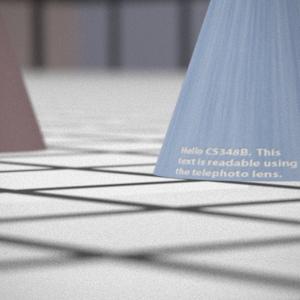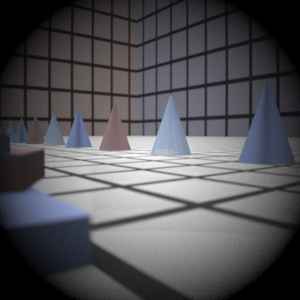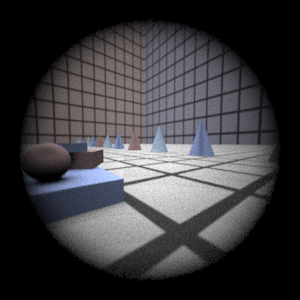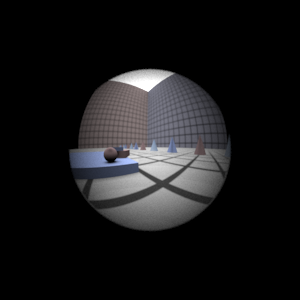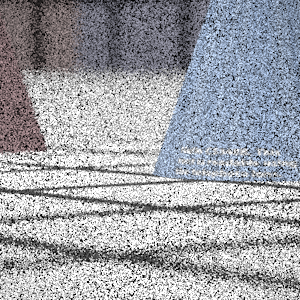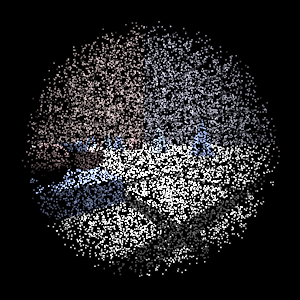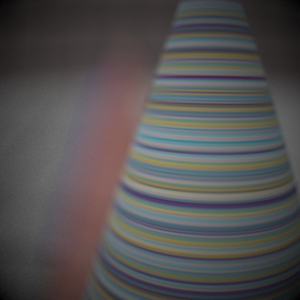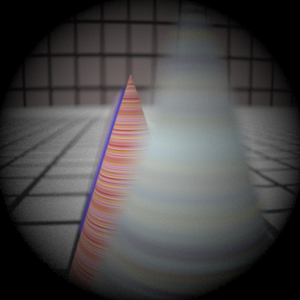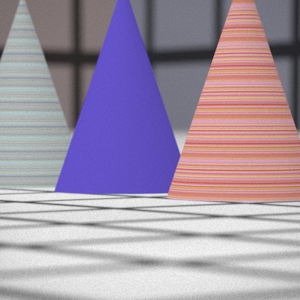Assignment 3 Camera Simulation
Sean Rosenbaum
Date submitted: ?? May 2006
Code emailed: ?? May 2006
Lots of images on the way!!!!
Compound Lens Simulator
Description of implementation approach and comments
Debugging
Once all the code for tracing rays through the lens was in place, I found my implementation too bugged to produce meaningful results. While I managed to track down several bugs using the debugger, I was still getting junk. I verified my transformations were working correctly by substituting pbrt's perspective camera into my code. This confirmed that my tracing was to blame. After several hours of frustation, I decided to produce a visualization as suggested in the assignment description. The visualization shows where each lens is located, the path of rays through the system, and the normals of the elements they hit. For simplicity, the visualization is in 2D, with the top display showing the lens from the (-z)-x plane and the bottom the (-z)-y plane. This visualization helped immensely. Shortly after it was in operation I managed to hunt down the remaining bugs.
[CamViz.jpg]
Final Images Rendered with 512 samples per pixel
|
My Implementation |
Reference |
Telephoto |
|
|
Double Gausss |
|
|
Wide Angle |
|
|
Fisheye |
|
|
Final Images Rendered with 4 samples per pixel
|
My Implementation |
Reference |
Telephoto |
|
|
Double Gausss |
|
|
Wide Angle |
|
|
Fisheye |
|
|
Experiment with Exposure
Image with aperture full open |
Image with half radius aperture |
|
|
Observation and Explanation
......
Autofocus Simulation
Description of implementation approach and comments
My algorithm relies heavily on the Sum-Modified-Laplacian (SML) to approximate the focus for a several film distances. The SML is computed for the autofocus zone at a given film distance using the intensity of the RGB values (i.e. max(R,G,B)) given by the camera sensor. In order to find the optimal film distance, I treated this as a one-dimensional optimization problem over a unimodal function. I first attempted to do a bisection-like search over the search range (which I set to cover a large range). This entailed taking two sample film distances near the center of the interval, computing the SML for each, and then continuing on to the interval on the side of the sample with the greater focus. Technically, the subinterval between the two samples is also included, as the maximum may fall within it. After this was fully functional, I was disappointed in how slow it went because the focus calculations are quite expensive. After perusing some literature on 1D optimization, I found that I could get by doing only one SML for each iteration, rather than two, by doing a golden section search. This algorithm is similar to the previous one. The general idea is to pick a sample position in the interval that can be reused in subsequent iterations. However, it is subject to the constraint that during each iteration, the current pair of points have the same relative positions in their interval as the previous points had. This ensures we continue to shrink the interval by a constant fraction at each iteration. This cut the autofocus time roughly in half.
Unfortunately, I ran into trouble doing these types of searches. The main problem was the SML was subject to error given that it is only an approximation. Consequently, my search would sometimes skip over a subinterval containing the optimal distance. My solution was to subdivide the search-range into several intervals, run the golden-section search on each one, and take the best film distance. This made my autofocus much more robust, though a bit slower. It can be made nearly as fast as a single golden-section search by immediately halting the computation for some of the intervals once it's apparent the optimal distance lies outside it. For instance, if a reasonably good focus is found in one interval, there's probably no need to search other far off intervals. Also, if the focus seems extremely bad when an interval is started, there's probably no need to continue searching it. I took advantage of this behavior by immediately halting computation for any intervals encountering several consecutive SML results below some fraction of the current best from prior intervals, or below a predefined threshold.
I handle several autofocus(AF) zones by replacing the SML above with a sum of SMLs, each term weighted by the area of its zone. This simply attempts to optimize the focus over all the zones.
Overall, this AF system strives to produce good, nearly optimal results, in a reasonable amount of time. One other compromise I had to make to achieve this goal was setting the number of samples taken per pixel in each AF zone below what Kayvon recommended.
Future Work
Successive parabolic interpolation may be more efficient than golden-section search given it's faster convergence rate. This technique works by sampling several distances, forming a parabola over the results, computing the minimum of this parabola, and successively refining it.
SML has a several parameters, including a step size for computing MLs and a minimum threshold for summing them. I initially picked these numbers out of a hat, and did not spend much time tweaking them. I suppose there is opportunity here to get even better results.
References
Shree K. Nayar. Shape From Focus System. IEEE Conference on Computer Vision and Pattern Recognition (CVPR), pp.302-308, Jun, 1992.
Michael T. Heath. Scientific Computing, An Introductory Survey - 2nd Ed. McGraw-Hill, 2002.
Final Images Rendered with 512 samples per pixel
|
Adjusted film distance |
My Implementation |
Reference |
Double Gausss 1 |
mm |
|
|
Double Gausss 2 |
mm |
|
|
Telephoto |
mm |
|
|
Any Extras
...... Go ahead and drop in any other cool images you created here .....

